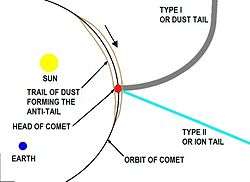Antitail


An antitail is a spike projecting from a comet's coma which seems to go towards the Sun, and thus geometrically opposite to the other tails: the ion tail and the dust tail. However, this phenomenon is an optical illusion that is seen from the Earth. The antitail is formed of larger dust particles, which are less affected by the Sun's radiation pressure and tend to remain roughly in the comet's orbital plane and eventually form a disc along the comet's orbit due to the ejection speed of the particles from the comet's surface. As Earth passes through the comet's orbital plane, this disc is seen side on, and appears as the characteristic spike.[1] The other side of the disc can sometimes be seen, though it tends to be lost in the dust tail. The antitail is therefore normally visible for a brief interval only when Earth passes through the comet's orbital plane.[2][3]
Most comets do not develop sufficiently for an antitail to become visible, but notable comets that did display antitails include Comet Arend–Roland in 1957, Comet Hale–Bopp in 1997 and Comet PANSTARRS in 2013.
See also
- Comet tail
- The coma and tail at the main Comet article.
Notes
- ↑ "Encyclopedia of science:antitail".
- ↑ Rao, Joe (6 February 2009). "Newfound Comet Lulin to Grace Night Skies". SPACE.com. Archived from the original on 26 February 2009. Retrieved 2009-02-25.
- ↑ Tosar, Borja; Paolo Candy. "What is an antitail". 3.bp.blogspot. Archived from the original on 25 February 2009. Retrieved 2009-02-25.
External links
- Emily Lakdawalla (2009-02-23). "Got binoculars? Spot a comet near Saturn tonight".
- Online Encyclopedia of Science - Antitail

